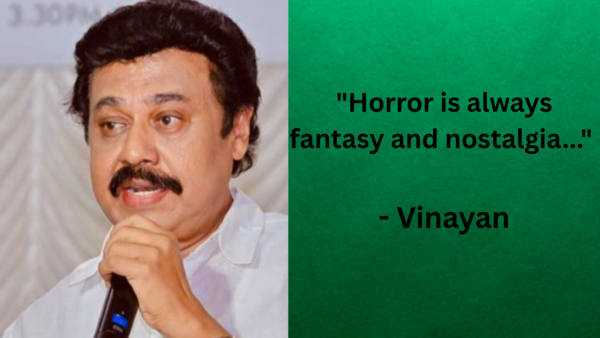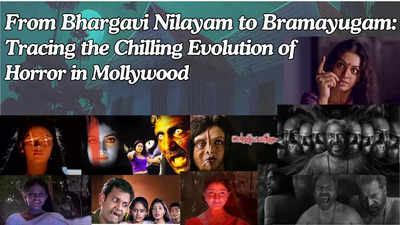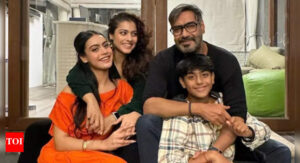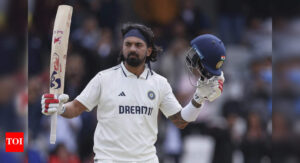From ‘Bhargavi Nilayam’ to ‘Bramayugam’: Tracing the Chilling Evolution of Horror in Mollywood | Malayalam Movie News

Among all genres, horror stands out, as people love experiencing the spine-chilling atmosphere it creates—whether in a cinema or while binge-watching at home. Many in the audience enjoy watching horror films, even if they cover their eyes during particularly gruesome scenes. Over time, when filmmakers began revealing how they created blood effects, prosthetics, and other behind-the-scenes techniques, audiences started examining how those scary scenes were crafted using ordinary methods—nothing supernatural at all.
When we look at the evolution of horror films, particularly in the Malayalam industry, there’s been a tremendous shift in storytelling and visual narration. Earlier films often revolved around a woman who died prematurely, usually due to brutal acts committed by a group of men or enemies. As a ghost, her primary motive would be to exact revenge on those responsible for her death. Some films, like Meghasandesam (2001) and Vellinakshatram (2004), portrayed ghosts returning not just for revenge, but to fulfil a lingering love for someone still alive.
The Malayalam film industry, celebrated for its realistic storytelling and thematic depth, has had a fascinating journey in the horror genre. While mainstream Malayalam cinema has traditionally favoured socially relevant dramas or family-centric narratives, the horror genre—though sporadically explored—has always left a lasting impact when executed well. From the spine-chilling Aakasha Ganga (1999) to the eerie monochrome brilliance of Bramayugam (2024), the depiction of ghosts and supernatural elements has undergone a striking transformation. This shift is not only visual but also deeply rooted in cultural transitions, narrative techniques, and audience psychology.
“Horror is always fantasy and nostalgia…” – Vinayan
It is impossible to discuss the evolution of horror in Mollywood without mentioning Indian film director and screenwriter Vinayan, known for crafting some of the most celebrated horror films in Malayalam cinema, including Aakasha Ganga, Vellinakshatram, and Yakshiyum Njanum.
In a recent conversation, Vinayan shared some behind-the-scenes stories from shooting these films at a time when technology was not as developed. “There have been changes over the years in the genre,” Vinayan told ETimes.

When asked about the shift in horror themes—from vengeful women in white sarees to psychological thrillers—Vinayan explained, “For me, horror is always fantasy. It’s nostalgia, a different kind of genre. Some are tight with terrifying elements, like in Bramayugam, where Mammootty’s body is taken over by a chathan (supernatural entity), and so on. But my favourite horror film that still holds a special place in my heart is Bhargavi Nilayam. For me, horror is a part of our culture. Growing up in Kerala, it was influenced by local traditions—even though now, most of us take references from Hollywood films. The idea of a ghost for me is a yakshi—a female spirit with elements of revenge, love, beauty, and lust. It’s always someone who died without fulfilling her desires. That’s how Aakasha Ganga came to life in 1999. In the film, I felt like I was floating between two boats—one that strongly opposed superstition, and the other that embraced mythology.”
He revealed that the scene in Aakasha Ganga, where Innocent and Jagadish’s characters perform a fake divine ritual (kallathullal), was based on a myth he heard from his mother during childhood. The legend behind Aakasha Ganga—where a dasi (servant girl) is burned alive by the Thampuran for falling in love with his son—was believed to be real in Vinayan’s native village. He admitted to incorporating elements like thullal from his village’s folklore into the story. “The genre has changed in many ways. But at its core, horror has always been about someone who died without fulfilling a wish, carrying sorrow while seeking revenge. That emotion remains in every horror film. Love and revenge of the dead—those are at the heart of it,” he said.
Vinayan also discussed how he shot certain scenes in Aakasha Ganga at a time when VFX, make-up, and technical support were minimal. “There was no CGI in 1999. We had a limited budget. Today, morphing and editing are affordable. Back then, even simple morphing scenes, like Mayoori’s character transforming into a cat or an owl, cost around ten thousand rupees. We could only afford one or two such shots, which we reused to enhance the horror element,” he stated.
He credited art director RK for helping him shoot several horror scenes live. For example, they filmed a ghost appearing and advancing from a wall using a Michelle camera. Another scene involved Spadikam George running while slices of wood flew behind him. That effect was achieved by using miniatures. Similarly, Mayoori’s character appearing larger than the nalukettu (traditional homestead) was done using a scaled model. “If we shot that now, the audience might not be impressed. But back then, it worked because of the effort involved. We also filmed Divya Unni’s character killing Shivaji using tree roots—all done manually. No CGI—just assistants pulling roots frame by frame. We used a vacuum cleaner to create waves in a pond for a scene where Innocent’s character is bathing and the servant transforms into a ghost. Even stereo miking was used for sound effects. That was our only aid. Even today, children call me after watching Aakasha Ganga on TV to say they liked it,” he smiled. He firmly believes the film became timeless because of the passion they poured into it.
Vinayan also recollected working on Athbhutha Dweepu in 2005, revealing that Jagathi’s dwarf appearance was not CGI but a clever lens adjustment technique. “I spent around Rs 2.8 crore on that film. Today, it would cost Rs 100 crore. But I did it because of my fascination with technology. I feel proud when I watch Aakasha Ganga even today. It’s better than many recent films that relied on technology,” he added.
When asked about the genre’s evolution into psychological horror, like Fazil’s Manichitrathazhu or Rahul Sadasivan’s Bhoothakaalam, Vinayan responded, “Manichitrathazhu explored mental health, which is why it stood out from films like Bhargavi Nilayam. The same goes for Bramayugam. The idea of a ghost or supernatural presence is closely linked to a viewer’s psychology. I don’t mind such thrillers—they’re a variety within horror.”
Vinayan added that his own version of the lovable yet haunting yakshi is a recurring presence in his films, especially Vellinakshatram (2004). He often drew inspiration from real-life stories, like those in Karumadikkuttan and Dada Sahib. “I pull from childhood memories in Kuttanad, where my mother would sit facing the kavu (sacred grove) and the pala tree, wondering if there was a ghost living in it. When the wind blew, I used to think, ‘Is that the yakshi’s saree fluttering?’” he laughed, recalling his 10-year-old self.
Many had told him that ghosts in white sarees were outdated, ever since Bhargavi Nilayam. But he trusted his vision. “People said white saree ghosts wouldn’t work anymore. But I knew Aakasha Ganga would resonate. After its success, I built a temple in memory of my mother near our village. She passed away in my teenage years. When I made the film, I had this strong feeling—an intuition—that she might be upset about the thullal scene mocking a local ritual. So I wanted to make peace with that and honour her wishes.”
He reflected, “When a story or myth from our childhood inspires us, it reflects in our films. It’s all fantasy and entertainment—we should approach it that way. Vellinakshatram beautifully expressed the bond between a mother and her child, even after death. A film succeeds when it can take the audience on that fantastical journey. Good songs, drama, comedy—all of it adds value.”
When asked about Summer Palace, where the traditional female ghost trope was replaced by a male ghost, Vinayan said, “Hollywood has done many such films. We took inspiration from that too. But for me, a woman seeking revenge stays closer to our culture. The real thrill lies in a woman returning—as a yakshi—to take revenge,” he concluded with a laugh.
From Bhargavi Nilayam to Aakasha Ganga
Bhargavi Nilayam, a romantic horror film directed by debutant A. Vincent, was the first horror film in Malayalam cinema. Starring Madhu, Vijaya Nirmala, Prem Nazir, and P.J. Antony, the film introduced the ghost in a white saree—a trope that continued in several films, despite it being shot in black and white.
Regarded as the first true horror film in Mollywood, it was groundbreaking in many ways. Written by the legendary Vaikom Muhammad Basheer and based on his short story Neelavelicham, the film blended poetic melancholy with supernatural elements. Unlike the loud, terrifying ghosts of later films, Bhargavi Nilayam gave Malayalam audiences a tragic, romantic ghost—a restless spirit longing to be heard rather than feared.
This marked the beginning of Malayalam horror’s unique identity—deeply emotional, rooted in folklore, and culturally nuanced. Over the decades, the genre has transitioned from melodramatic chills and revenge sagas to psychological horror and philosophical dread.
From Spirits to the Mind
Following the melancholic elegance of Bhargavi Nilayam in 1964, Malayalam horror entered a new phase in the early 1990s with the release of Manichitrathazhu (1993). Directed by Fazil, this psychological horror-thriller is arguably one of the most iconic Malayalam films ever made—not just within the horror genre, but across Indian cinema. What made Manichitrathazhu stand out was its rejection of the typical ghostly narrative. Instead of relying on supernatural frights, it introduced audiences to the terrifying complexities of the human mind. Shobana’s character, Ganga, suffering from dissociative identity disorder, transforms into the haunting figure of Nagavalli—a character deeply rooted in cultural memory and suppressed trauma. This shift from external to internal horror was groundbreaking, and the film’s success sparked remakes in several Indian languages, proving that horror could be both cerebral and culturally grounded.
Akasha Ganga (1999), directed by Vinayan, reintroduced the vengeful female spirit in all her dramatic, terrifying glory. Rooted in folklore and temple traditions, the film captivated audiences with its blend of myth, gore, and sentimentality. The ghost here wasn’t merely a spooky figure—it had a history, a motive, and a tragic backstory that called for justice.
However, just a year later, Summer Palace (2000) would mark a quiet but notable shift in the portrayal of ghostly characters. Directed by K Murali, the film took the unusual route of featuring a male ghost—Krishna Kumar—breaking away from the genre’s female-centric spirit narratives. Rather than vengeance, this male spirit lingered for emotional closure, offering viewers a more introspective and sorrowful haunting.
Vellinakshatram (2004)
Films like Vellinakshatram (2004) attempted to blend the horror genre with humour and family drama. While ghosts remained visible and theatrical, their portrayal started to become more stylised. The industry, limited by budget and VFX capabilities, often relied on practical effects—white sarees, wind-blown hair, rolling eyes, and echoing voices.
This period also saw a shift in the ghost’s purpose. From vengeful spirits, they slowly evolved into beings with emotional backstories, sometimes even playing a protective or moralistic role. However, the formulaic treatment began to make horror predictable, leading to a temporary decline in audience interest.
A New Wave of Narration in Ezra and Pretham
With the onset of the New Gen wave in Malayalam cinema, horror films also underwent reinvention. Movies like Ezra (2017) and Pretham (2016) brought fresh narratives and a polished aesthetic. Ezra, in particular, stood out with its blend of Jewish mysticism, an international setting, and high production value. The ghost in Ezra was more atmospheric—its presence felt in shadows, flickering lights, and creaking doors, rather than through sudden jump-scares. The film combined emotional trauma with supernatural mystery, indicating a shift towards psychological horror.
Pretham, starring Jayasurya, explored a more light-hearted route, introducing a ghost psychologist. The ghosts here were not just tools of fear but mediums for storytelling—used to convey trauma, regrets, and the need for closure.
This era leaned into the seen but not shown philosophy—ghosts were more about their influence on the living than their physical manifestation. Audiences were expected to think, not just scream.
Lijo Jose Pellissery’s Churuli
As Malayalam cinema continued to experiment with genres and forms, horror began to merge with history, mystery, and folklore. Films like Churuli (2021) by Lijo Jose Pellissery blurred the lines between psychological horror, sci-fi, and mysticism. Though not a ghost story in the traditional sense, it evoked a sense of dread and disorientation that lingered long after the credits rolled.
This period saw filmmakers taking creative liberties, drawing from regional myths, oral traditions, and indigenous rituals to tell deeply rooted, culturally resonant horror stories.
Rahul Sadasivan’s Bramayugam and Bhoothakaalam
With Bramayugam (2024), director Rahul Sadasivan continues to redefine horror in Malayalam cinema, building on the atmospheric storytelling seen in his earlier works such as Red Rain (2013) and Bhoothakaalam (2022). While Red Rain explored sci-fi horror through the lens of extraterrestrial mystery, Bhoothakaalam delved into the psychological weight of grief and trauma within a haunted home.
In Bramayugam, Sadasivan shifts gears once again—this time plunging viewers into a dark, oppressive feudal past where fear is rooted in silence, power, and the unknown. Presented in haunting black and white, the film stars Mammootty in a role that is as enigmatic as it is terrifying, blurring the line between man and myth. Rather than relying on traditional jump-scares, Bramayugam thrives on slow-building dread and allegorical tension, exploring themes of caste, dominance, and spiritual decay.
With this film, Sadasivan firmly establishes himself as a genre-bending storyteller, bringing a cerebral, stylistic edge to Mollywood horror that both respects tradition and dares to disturb it.








